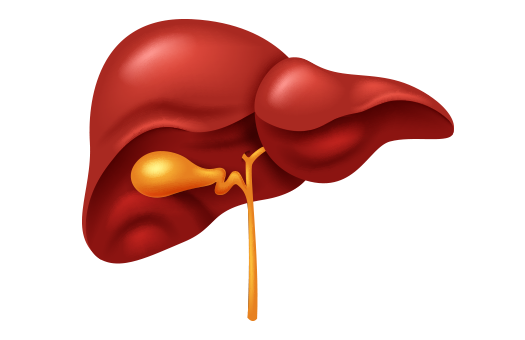Many people do not know much about Fatty Liver Disease. They might see it as something that do not concern them. This condition causes physical health imbalance but having said that, there are no signs or symptoms in the early to intermediate stages of the disease.
Studies have also shown that though patients have not had liquor or got infected by hepatitis, fatty liver disease is one of the main cause of cirrhosis or chronic hepatitis.

The liver is the largest organ in the body and weighs about 1,200-1,500 grams. It looks like a pyramid in the abdominal cavity, which is located under the right costa border. The function of the liver is complex. It is an organ that is vital to our life because it is related with several other functions of our body. Some examples are as follows:
-
Produces bile to digest and disintegrate fat from food
-
Synthesizes many type of substances that are essential to the function of the body, such as amino acids, vitamins, and hormones
-
Maintains the energy and metabolic balance
-
Acts as the storage place for carbohydrates, vitamins and minerals
-
Purifies toxic substances that are delivered via the blood, such as waste from the metabolism of the body, ammonia, degenerated red blood cells, medicines and toxins that the body accumulates
When the liver is functioning normally, millions of cells will work in harmony which in turn can help boost the body’s excellent self-repair mechanism. As mentioned, during the early stages, there might be no symptoms or any change in the blood chemistry. This fact causes a lot of people to unknowingly neglect the importance of a healthy liver. Here are some factors that can harm the liver cells:
-
viral infection
-
alcohol consumption
-
continuous overdose of medications
-
inflammation to the liver cells and tissues
-
secondary medical factors
When there are more lesions and the liver cells function reduces, the production of liver enzyme may become higher from the inflammation of the liver tissues and in turn causes many side-effects. Some of the common signs and symptoms of the Fatty Liver Disease are as follows:
-
chest pain under the right costa border
-
frequent flatulence
-
indigestive food
-
feeling fatigued easily from congestion of toxins in the body
-
loss of energy and metabolic balance that are lost
-
jaundice and itching on the skin
Some of the long term effects caused by liver degeneration are as follows:
-
edema
-
abnormal bleeding
-
brain disorder
-
confusion
-
capillaries around the abdominal skin or chest may bulge like a cobweb
-
immunity will become low and it becomes easy to get infected

Causes of Fatty Liver Disease
-
Metabolic syndrome
According to the statistics, about 50-90% of patients from this group are at risk of having the Fatty Liver Disease. In Thailand, the criteria used to diagnose Metabolic syndrome are as follows:
a.Thai males with a waistline of more than 90 centimeters
b.Thai female with waistline of more than 80 centimeters
c.Physical check-ups with the following results:
- The blood pressure is higher than or equivalent to 130/85 mmHg.
- Hyperglycemia is from 100 milligrams per deciliter and above.
- High triglyceride is from 150 milliliters per deciliter and above.
- HDL cholesterol is lower than 40 milligrams per deciliter for males or lower than 50 milligrams per deciliter for females.
From the abovementioned, we can classify these patients into those with Metabolic syndrome. Fats in the abdominal cavity might accumulate in the intestinal mucus or the liver cells which can activate inflammation. This in turn can well be the leading cause of insulin resistance in diabetic patients.
-
Causative toxins that affect the liver cells are as follows:
a.Alcohol consumption
b.Insecticide in vegetables and fruits
c.Nonsteroidal anti-inflammatory (NSAID) drugs like:
- diclofenac
- ibuprofen
- naproxen
- analgesic
- antipyretic drugs, such as paracetamol
- immunosuppressive drugs such as methotrexate
In normal cases, the liver is the organ that will be used to eliminate the toxins from the factors mentioned above. Thus, when the body receives too much medicine and toxins, it can cause severe harm to the liver cells and tissues.

A. Irritable bowel syndrome
Many research studies have found the connection between Irritable Bowel Syndrome and Fatty Liver Disease with regular constipation or diarrhea. It is believed that the imbalance of good bacteria in the gastrointestinal tract will cause the growth of foreign pathogens, such as yeast, fungus or bad bacteria that can produce endotoxins. They can spread into the blood vessels through the weak intestinal mucus, which may then cause injury or inflammation to the liver cells. The gastrointestinal medical researchers believe that the development of lesions in hepatitis, cirrhosis or liver cancer might come from various co-related factors based on the Multihit Theory.
As we all know, prevention is still the best option. Having said that, early detection and management is the best treatment window for the disease because the liver can repair itself and can be completely be cured at this stage (Reversible stage). However, if we wait until the symptoms or lesions become too severe and when cirrhosis occurs (Irreversible stage), supportive therapy or liver transplant may be needed. The option of finding a donor organ that is compatible with an individual can be very difficult.
The occurrence of the Fatty Liver Disease is due to several contributing factors. The Integrative Medicine treatment model which includes patient involvement (lifestyle and diet) is a highly effective treatment method in obtaining a good prognosis. Some of the examples are as follow:
-
Behavioral adjustments are needed in order to turn back the body’s biological clock and metabolic balance. Some changes are as follow:
-
avoid sleeping late
-
wake up early to exercise to activate the hormones, metabolic system, and immune system
-
eat breakfast for the body to receive complete nutrients
-
chew food for a long time to support the digestive system
-
choose food that is appropriate for the body or blood group
-
reduce carbohydrates or fat intake, especially at dinner time
The aim here is to enhance the metabolic functions of the body plus to also disintegrate excess fat in the abdominal cavity, liver tissues and subcutaneous.
-
Avoid introducing toxins to the body. For example:
-
choose to consume organic fruits and vegetables
-
clean all kinds of fruit and vegetable before eating
-
avoid using painkillers if not necessary
-
reduce the consumption of alcoholic drinks
-
abstain from smoking
-
chose cosmetics or hair dye that is made from natural products rather than general chemicals
-
avoid eating peanuts that are roasted for a long time because you might obtain aflatoxins from fungus
-
Use nutritional therapy to support the function of liver cells. There are many naturopathy studies that talk about natural nutrients that promotes the production of the enzymes in the liver to eliminate toxins. For example:
-
Silymarine in milk thistle
-
Thiol in fresh garlic, shallot, or strong-smelling vegetables, such as celery
-
amino acids, such as cysteine, glutamine, and glutathione which plays an important role in eliminating toxins from the liver
-
anti-oxidants, such as Vitamin C, Vitamin E, Coenzyme Q10, and selenium
-
the use of probiotics to adjust the balance of the gastrointestinal tract
All of these are important nutrients that work together like an orchestra that helps to support the liver cells in the process of detoxification.
-
Detoxification treatment method by using naturopathy, such as colon hydrotherapy and detoxification of heavy metals through chelation therapy. These methods of alternative treatment aims to reduce the accumulated of toxins in the body in order to alleviate the burden from the liver cells.
-
Support the repair and restoration of the liver cells, such as the use of nutrients like peptide or homeopathy drugs, which is another form of alternative treatment method which is common in many European countries. Studies have shown that the outcome of the method mentioned have been positive.
Conclusion
Apart from the treatments mentioned above, the results ultimately depend on patients’ attitude. Disease knowledge is extremely important in order for patients to make necessary lifestyle adjustments. The doctor mainly acts as a coach who will provide a better understanding of the disease, plan of care and at the same time provide all the support the patient needs. Therefore, apart from the lifestyle adjustments, patients are strongly encouraged to do regular checks in order to detect the problem early and plan the best curative path.




Sign In
Create New Account